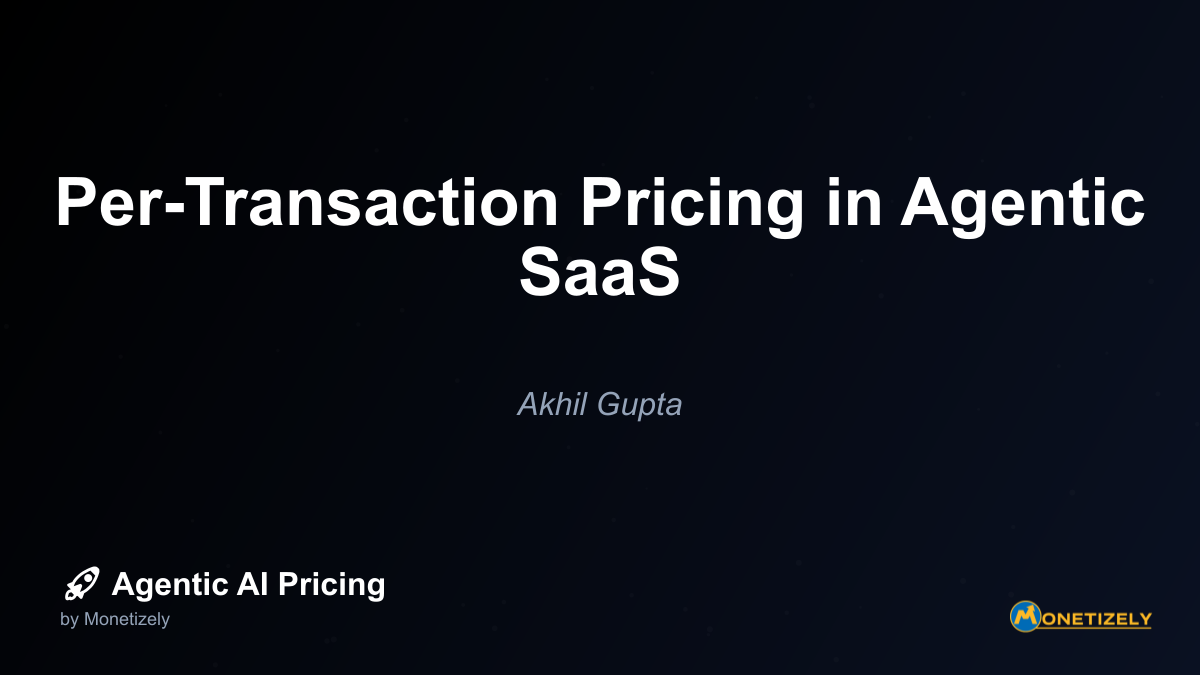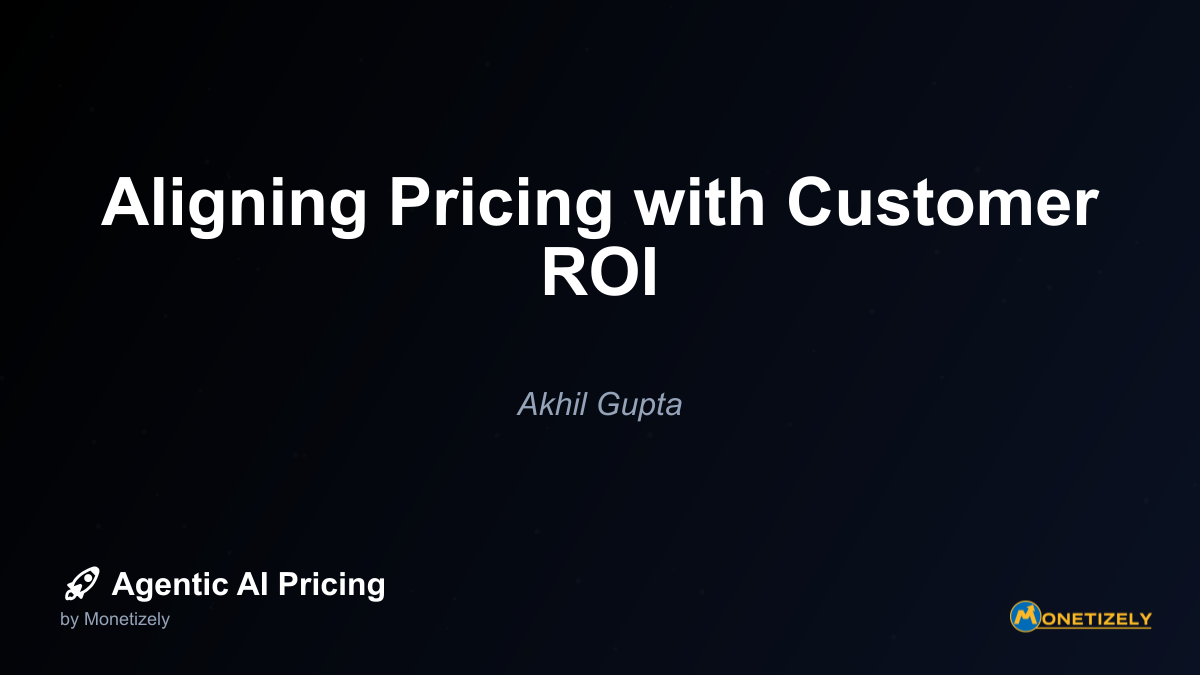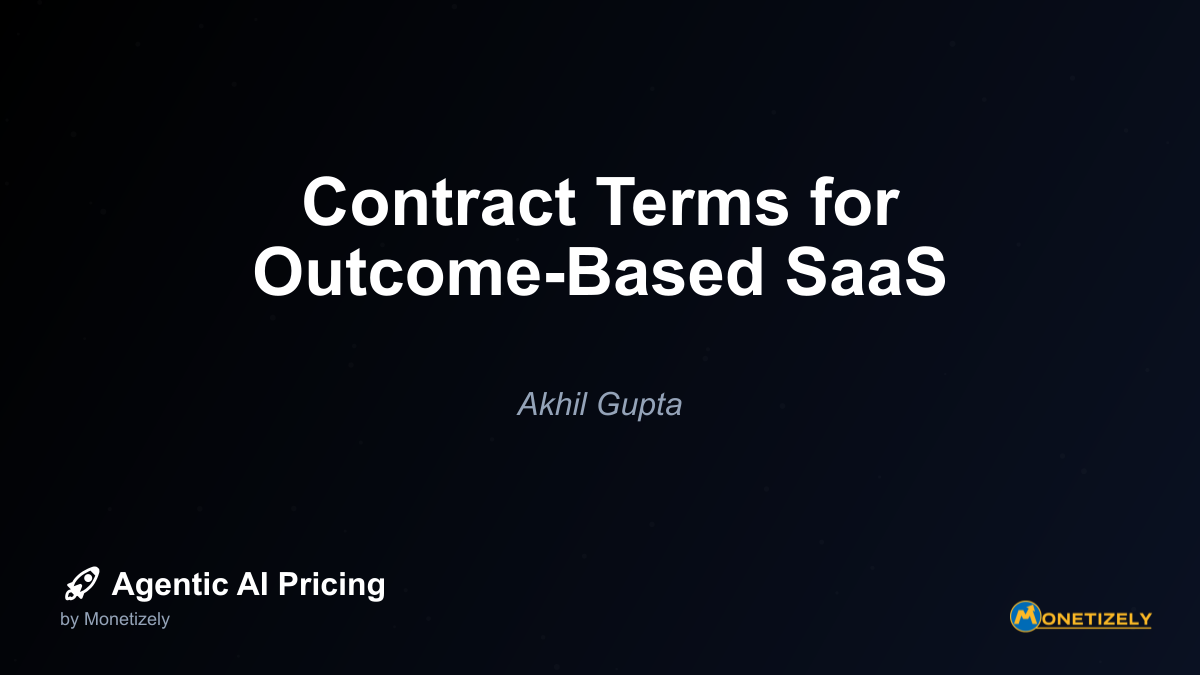· Akhil Gupta · Pricing Agentic SaaS Products · 9 min read
Per-Transaction Pricing in Agentic SaaS
AI and SaaS Pricing Masterclass
Learn the art of strategic pricing directly from industry experts. Our comprehensive course provides frameworks and methodologies for optimizing your pricing strategy in the evolving AI landscape. Earn a professional certification that can be imported directly to your LinkedIn profile.

2. Risk Mitigation for Customers
Per-transaction pricing significantly reduces the risk for customers adopting agentic AI solutions. Rather than committing to an expensive subscription before knowing if the AI agent will deliver results, customers only pay when the agent successfully completes a task. This model creates a powerful incentive for first-time buyers who may be hesitant about the technology’s capabilities.
3. Performance Incentives for Providers
From the provider’s perspective, transaction-based pricing creates a strong incentive to ensure AI agents perform effectively. Since revenue is directly tied to successful task completion, providers are motivated to continuously improve their agents’ capabilities, reliability, and efficiency.
4. Scalability Across Usage Levels
Transaction pricing works effectively across various usage levels, from occasional users to enterprise-scale deployments. Small businesses can start with minimal investment and scale up as they see results, while large enterprises can deploy agents broadly with costs proportional to actual utilization.
5. Transparency and Predictability
When properly implemented, per-transaction pricing offers clarity that customers appreciate. They can easily calculate the cost of specific business outcomes and assess ROI with precision, unlike subscription models where utilization rates significantly impact the effective cost per transaction.
Implementing Per-Transaction Pricing for Agentic SaaS
Successfully implementing a transaction-based pricing model requires careful planning and execution. Here are the key considerations for agentic SaaS providers:
Defining the Transaction Unit
The foundation of transaction-based pricing is a clearly defined “transaction” that customers and the system can easily understand and measure. When defining transaction units:
- Choose actions that represent complete, valuable outcomes
- Ensure transactions are discrete and countable
- Select units that align with customer value perception
- Define success criteria unambiguously
- Consider the complexity and resource requirements of different actions
For example, an AI sales agent might charge per qualified meeting booked rather than per prospect contacted, as the booked meeting represents the valuable outcome.
Determining Appropriate Pricing Points
Setting the right price per transaction is critical to the success of this model. The price should:
- Reflect the value delivered to the customer
- Account for your costs (including AI operational costs)
- Consider competitive alternatives (both AI and human)
- Allow for healthy profit margins
- Be simple enough for customers to understand
Many successful agentic SaaS companies begin by benchmarking against the human cost of performing the same task. For instance, if a human assistant costs $25/hour and can process 10 customer support tickets in that time, a starting point might be $2.50 per ticket for an AI agent.
Comparing transaction-based and performance-based models can help determine which approach best aligns with your specific AI application and customer expectations.
Building the Metering Infrastructure
Transaction-based pricing requires robust metering infrastructure to track and count completed actions accurately. This infrastructure must:
- Define clear start and end points for each transaction
- Track successful completions versus attempts
- Provide real-time visibility for customers
- Integrate with billing systems
- Handle edge cases and partial completions
- Scale to accommodate volume fluctuations
Many agentic SaaS providers underestimate the complexity of building reliable metering systems. Consider using specialized billing platforms that support usage-based models rather than building custom solutions from scratch.
Creating Transparent Billing Mechanisms
Customers expect clear, understandable billing when using transaction-based services. Effective billing mechanisms should:
- Provide real-time usage dashboards
- Offer detailed transaction logs
- Support various payment methods
- Include spending limits and alerts
- Generate comprehensive invoices
- Allow for prepayment options
Transparency builds trust, particularly important in the early adoption phase of agentic AI where customers may be skeptical about both the technology and the billing model.
Common Variations of Per-Transaction Pricing
While the basic model charges a flat fee per transaction, several variations have emerged to address specific business needs:
Tiered Transaction Pricing
Tiered pricing offers volume discounts as usage increases, encouraging customers to expand their usage of AI agents. For example:
- 1-1,000 transactions: $1.00 each
- 1,001-10,000 transactions: $0.80 each
- 10,001+ transactions: $0.60 each
This approach rewards scale while maintaining the pay-for-results philosophy of transaction-based pricing.
Outcome-Weighted Transactions
Some agentic SaaS providers differentiate pricing based on the value of different transaction types. For instance, an AI sales agent might charge:
- $2 for qualifying a lead
- $10 for booking an initial meeting
- $25 for facilitating a closed deal
This approach more precisely aligns pricing with the varying value of different outcomes.
Hybrid Models
Many successful agentic AI companies combine transaction pricing with other models:
- Base subscription + per-transaction fees
- Free tier with limited transactions, then per-transaction pricing
- Transaction bundles sold in advance at discounted rates
- Outcome-based pricing for high-value transactions with flat fees for routine ones
These hybrid approaches can provide revenue stability while maintaining the alignment between usage and value.
Industry-Specific Applications of Per-Transaction Pricing
Transaction-based pricing models vary significantly across industries based on the specific value AI agents deliver:
E-commerce and Retail
In e-commerce, AI agents can handle various customer interactions and operational tasks with transaction pricing based on:
- Successful product recommendations leading to purchase
- Customer service inquiries resolved
- Inventory management decisions executed
- Pricing optimizations implemented
- Returns processed and resolved
For example, an AI shopping assistant might charge $0.50 per customer inquiry resolved, plus 1% of any resulting purchase value, creating alignment between the agent’s actions and the business outcomes.
Sales and Marketing
AI agents in sales and marketing are particularly well-suited to transaction pricing since outcomes are discrete and valuable:
- Leads qualified
- Meetings scheduled
- Proposals generated
- Follow-ups conducted
- Deals closed
A common approach is to charge nominal fees for early-funnel activities and premium fees for late-funnel activities that directly impact revenue.
Customer Service
In customer service, transaction pricing typically revolves around ticket resolution:
- Simple inquiries resolved (tier 1 support)
- Complex issues addressed (tier 2 support)
- Technical problems solved (tier 3 support)
- Customer retention interventions
- Upsell/cross-sell conversations
Pricing often varies based on complexity, with simple inquiries costing less than complex technical support interactions.
Financial Services
AI agents in financial services can handle transactions like:
- Fraud alerts investigated
- Loan applications processed
- Investment recommendations provided
- Account reconciliations performed
- Compliance checks completed
Due to the regulated nature of financial services, transaction pricing must carefully account for compliance requirements and potential liability.
Healthcare
In healthcare, transaction pricing for AI agents might include:
- Patient scheduling completed
- Insurance verifications processed
- Medical records reviewed
- Clinical documentation assistance
- Billing and coding support
Healthcare applications must navigate complex privacy regulations and often involve hybrid pricing models that account for the sensitive nature of the data involved.
Challenges and Considerations
While per-transaction pricing offers many advantages, it also presents unique challenges:
Defining Success Criteria
One of the most significant challenges is defining what constitutes a “successful” transaction. This requires clear metrics and sometimes third-party verification to avoid disputes about whether a transaction was completed successfully.
Handling Failed Transactions
Not all agent actions will succeed, raising questions about how to handle partial completions or failed attempts:
- Should customers pay for attempted but failed transactions?
- How are transactions that require human intervention billed?
- What happens when failure occurs due to external factors?
Most successful providers don’t charge for failed transactions but implement safeguards against abuse.
Managing Cost Predictability
While customers appreciate paying only for results, they also value predictability in their expenses. Consider offering:
- Monthly spending caps
- Volume commitments with discounted rates
- Usage forecasting tools
- Budget alert systems
These features help customers manage their costs while maintaining the benefits of the transaction model.
Aligning with Customer Success
The ultimate goal of transaction pricing is aligning provider incentives with customer success. This requires ongoing communication to ensure:
- Transaction definitions remain relevant
- Pricing reflects the evolving value delivered
- Customers understand how to optimize their usage
- The system isn’t being gamed or manipulated
Regular review of transaction patterns and customer feedback helps maintain this alignment.
Future Trends in Per-Transaction Pricing
As agentic AI continues to evolve, several trends are emerging in transaction-based pricing:
Dynamic Transaction Pricing
Advanced AI systems are beginning to implement dynamic pricing that adjusts transaction fees based on:
- Time of day/demand levels
- Complexity of specific requests
- Resource intensity required
- Value of outcomes generated
- Customer lifetime value
This approach optimizes both provider economics and customer value.
Multi-Agent Transaction Systems
As AI agents begin to work together in teams, pricing models are evolving to handle complex workflows:
- Orchestration fees for coordinating multiple agents
- Differentiated pricing for specialist versus generalist agents
- Bundle pricing for common agent combinations
- Value-sharing across agent providers in marketplaces
These models require sophisticated tracking and attribution systems.
Outcome Guarantees
Some providers are beginning to offer guarantees with their transaction pricing:
- Money-back guarantees for failed transactions
- Performance SLAs with penalty clauses
- Minimum success rate commitments
- Results-based pricing with upside sharing
These guarantees help overcome adoption hesitation, particularly for high-value transactions.
Implementing Your Transaction-Based Pricing Strategy
If you’re considering implementing per-transaction pricing for your agentic SaaS product, follow these steps:
1. Map Your Value Chain
Begin by mapping the complete value chain of your AI agent’s activities:
- What specific tasks does your agent perform?
- Which outcomes create measurable value for customers?
- How do these outcomes translate to customer ROI?
- What are the natural transaction boundaries?
This mapping helps identify the most appropriate transaction units.
2. Conduct Market Testing
Before full implementation, test your transaction pricing with a subset of customers:
- Offer side-by-side comparisons with subscription options
- Gather feedback on transaction definitions
- Monitor usage patterns and customer satisfaction
- Adjust pricing and transaction definitions based on findings
This testing phase is crucial for refining your approach.
3. Build Flexible Billing Infrastructure
Invest in billing infrastructure that can support various transaction models:
- Accurate metering and counting capabilities
- Support for tiered and volume pricing
- Ability to handle hybrid models
- Integration with customer dashboards
- Compatibility with common payment processors
This flexibility allows you to evolve your pricing as your product and market mature.
4. Educate Your Market
Many customers are unfamiliar with transaction-based pricing for AI. Develop clear educational materials:
- Case studies showing ROI calculations
- Comparison tools for different pricing options
- Usage simulators to estimate costs
- Clear definitions of transaction success criteria
- Transparent pricing calculators
Education reduces friction in the sales process and builds trust with potential customers.
5. Monitor and Iterate
Transaction pricing requires ongoing refinement:
- Track transaction success rates and customer satisfaction
- Monitor unit economics and profitability
- Compare actual usage to forecasts
- Gather competitive intelligence
- Adjust pricing and transaction definitions as needed
The most successful transaction pricing models evolve over time to better align with customer value and provider economics.
Conclusion
Per-transaction pricing represents one of the most natural and effective pricing models for agentic SaaS products. By charging based on completed actions rather than time or access, this approach creates a direct link between the value AI agents deliver and what customers pay.
The model offers significant advantages: reduced adoption risk for customers, strong performance incentives for providers, natural scalability, and clear ROI measurement. While implementing transaction-based pricing requires careful planning—particularly around transaction definition, metering infrastructure, and pricing strategy—the benefits typically outweigh the challenges.
As agentic AI continues to evolve, we expect transaction-based pricing to remain a dominant model, though increasingly combined with other approaches in sophisticated hybrid systems. The future will likely bring more dynamic and personalized transaction pricing, better aligned with the specific value each customer receives.
For SaaS executives exploring agentic AI, per-transaction pricing offers a compelling way to monetize AI capabilities while building customer confidence in this emerging technology. By focusing on charging for successful outcomes rather than mere access, transaction pricing helps bridge the gap between AI’s promise and its practical business value.
Co-Founder & COO
Akhil is an Engineering leader with over 16+ years of experience in building, managing and scaling web-scale, high throughput enterprise applications and teams. He has worked with and led technology teams at FabAlley, BuildSupply and Healthians. He is a graduate from Delhi College of Engineering and UC Berkeley certified CTO.
Pricing Strategy Audit
Let our experts analyze your current pricing strategy and identify opportunities for improvement. Our data-driven assessment will help you unlock untapped revenue potential and optimize your AI pricing approach.




